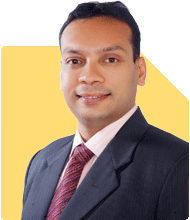Ramalingam Kalirajan |5367 Answers |Ask -Follow
Mutual Funds, Financial Planning Expert - Answered on Jun 04, 2024
He has an MBA in finance from the University of Madras and is a certified financial planner.
He is the director and chief financial planner at Holistic Investment, a Chennai-based firm that offers financial planning and wealth management advice.... more
.jpg)
I'm 40 years old, my take home salary is 1,97,000 per month. I have 2 years old son, I have zero savings and zero debt. Please suggest me the way to save and build a corpus for my retirement and child education.
Understanding Your Financial Position
1. Current Income and Expenses
Your take-home salary is Rs 1,97,000 per month. Without savings or debt, you have a clean slate to start your financial planning. Begin by understanding your monthly expenses. Track your spending for a few months to identify essential and non-essential expenses.
2. Monthly Budget
Create a detailed monthly budget. Allocate funds for necessary expenses like housing, utilities, groceries, and transportation. Identify areas where you can cut back to increase your savings rate. A disciplined approach to budgeting is crucial for financial success.
3. Emergency Fund
An emergency fund is a financial safety net for unexpected expenses. Aim to save at least 6-12 months’ worth of living expenses. This fund should be easily accessible and kept in a separate savings account.
Building a Strong Investment Portfolio
1. Goal Setting
Set clear financial goals for retirement and your son’s education. Determine how much you will need for both and the time frame to achieve these goals. This will help you plan your investments accordingly.
2. Investment in Mutual Funds
Mutual funds are an excellent way to build wealth over the long term. They offer diversification and professional management. Consider a mix of large-cap, mid-cap, and small-cap funds for growth. Consult with a Certified Financial Planner (CFP) to select the best funds based on your risk tolerance and goals.
3. Systematic Investment Plan (SIP)
A Systematic Investment Plan (SIP) allows you to invest a fixed amount regularly in mutual funds. This instills discipline and helps in averaging out market volatility. Start with an SIP that fits your budget and gradually increase it as your income grows.
4. Child Education Fund
Start a dedicated investment plan for your son’s education. Estimate the future cost of education, considering inflation. Invest in equity mutual funds for higher returns over a long period. Use SIPs to regularly contribute to this fund.
5. Public Provident Fund (PPF)
PPF is a long-term investment with tax benefits. It offers stable returns and is ideal for retirement planning. Open a PPF account and contribute regularly. The lock-in period helps in disciplined saving.
6. National Pension System (NPS)
NPS is another good option for retirement planning. It provides tax benefits and a steady income post-retirement. Consider investing in NPS for its diversified portfolio and long-term benefits.
7. Health and Life Insurance
Ensure you have adequate health insurance coverage for your family. Health insurance protects against high medical costs and ensures financial stability. Additionally, opt for a term life insurance policy covering at least 10-15 times your annual income. This ensures your family’s financial security in case of an unforeseen event.
Tax Planning
1. Maximizing Tax Deductions
Utilize tax-saving investments under Section 80C, such as ELSS, PPF, and life insurance premiums. This reduces your taxable income and increases your savings.
2. National Pension System (NPS)
NPS offers additional tax benefits under Section 80CCD(1B). Investing in NPS can reduce your tax liability and enhance your retirement corpus.
Regular Portfolio Review
1. Annual Review
Review your investment portfolio annually. Assess the performance of your investments and make necessary adjustments. This ensures your investments align with your financial goals.
2. Rebalancing
Rebalance your portfolio to maintain the desired asset allocation. This involves selling high-performing assets and buying underperforming ones to maintain balance.
Long-Term Focus and Patience
1. Stay Invested
Remain invested for the long term. Market fluctuations are normal, and staying invested ensures you benefit from compounding.
2. Avoid Impulsive Decisions
Avoid making impulsive decisions based on short-term market movements. Stick to your long-term plan for better returns.
Equity for Growth
Invest a significant portion in equity mutual funds for high returns. Equities can outpace inflation, ensuring your corpus grows over time.
Debt for Stability
Allocate funds to debt instruments for stability and regular income. This balances the high-risk equity component and provides a steady income stream.
Diversified Portfolio
Choose diversified mutual funds with a mix of equity and debt. This provides growth potential with reduced volatility.
Actively Managed Funds
1. Professional Management
Actively managed funds offer professional management. Fund managers make informed decisions to maximize returns.
2. Market Adaptation
These funds adapt to market conditions. They can outperform passive funds, especially in volatile markets.
Disadvantages of Index Funds
1. Lack of Flexibility
Index funds replicate the market. They lack the flexibility to adapt to changing conditions, which can limit growth potential.
2. Average Returns
Index funds typically provide average market returns. Actively managed funds aim to outperform the market, offering higher returns.
Regular Funds Over Direct Funds
1. Professional Guidance
Investing through regular funds provides professional guidance. A Mutual Fund Distributor (MFD) and CFP ensure your investments align with your goals.
2. Regular Reviews
Regular funds offer periodic reviews and adjustments. This maximizes returns and manages risks effectively.
Expense Management
1. Track Spending
Monitor your monthly expenses. Identify areas where you can cut back and save more. This helps in increasing your savings rate.
2. Budgeting
Create a budget and stick to it. Allocate funds for savings, investments, and necessary expenses. This ensures disciplined financial management.
Staying Informed and Educated
1. Financial Knowledge
Stay informed about financial markets and investment opportunities. Continuous learning empowers better financial decisions.
2. Regular Updates
Keep up with market trends and updates. This helps in making timely adjustments to your portfolio for optimal returns.
Tracking Progress and Adjustments
1. Financial Planning Tools
Use financial planning tools to track your progress. These tools help monitor investments and net worth, providing a clear picture of your financial health.
2. Make Necessary Adjustments
Adjust your investments based on changes in financial situation, goals, and market conditions. Stay flexible and proactive.
Consulting a Certified Financial Planner
1. Personalized Advice
A Certified Financial Planner (CFP) provides tailored advice. They help navigate complex financial decisions and optimize your strategy.
2. Regular Consultations
Schedule regular consultations with your CFP. This ensures you stay on track and make informed decisions based on changing financial circumstances.
Your dedication to starting financial planning at 40 is commendable. Building a secure future for yourself and your child is a responsible and thoughtful decision. Your proactive approach and willingness to seek guidance show a strong commitment to financial well-being.
Conclusion
By following this comprehensive financial plan, you can build a substantial corpus for retirement and your child’s education. Focus on disciplined saving, strategic investing, and regular portfolio reviews. With a clear plan and the guidance of a Certified Financial Planner, you can achieve financial security and a comfortable retirement.
Best Regards,
K. Ramalingam, MBA, CFP,
Chief Financial Planner,
www.holisticinvestment.in
You may like to see similar questions and answers below
Sunil Lala |193 Answers |Ask -Follow
Financial Planner - Answered on Jun 06, 2023
Vivek Lala |257 Answers |Ask -Follow
Tax, MF Expert - Answered on Jun 04, 2023
Moneywize |125 Answers |Ask -Follow
Financial Planner - Answered on Dec 29, 2023
Ramalingam Kalirajan |5367 Answers |Ask -Follow
Mutual Funds, Financial Planning Expert - Answered on May 17, 2024
Dr Nagarajan J S K |58 Answers |Ask -Follow
Health Science and Pharmaceutical Careers Expert - Answered on Jul 27, 2024
Dr Nagarajan J S K |58 Answers |Ask -Follow
Health Science and Pharmaceutical Careers Expert - Answered on Jul 27, 2024
Dr Nagarajan J S K |58 Answers |Ask -Follow
Health Science and Pharmaceutical Careers Expert - Answered on Jul 26, 2024
Krishna Kumar |358 Answers |Ask -Follow
Workplace Expert - Answered on Jul 26, 2024
Krishna Kumar |358 Answers |Ask -Follow
Workplace Expert - Answered on Jul 26, 2024
Krishna Kumar |358 Answers |Ask -Follow
Workplace Expert - Answered on Jul 26, 2024
Krishna Kumar |358 Answers |Ask -Follow
Workplace Expert - Answered on Jul 26, 2024
Krishna Kumar |358 Answers |Ask -Follow
Workplace Expert - Answered on Jul 26, 2024
Krishna Kumar |358 Answers |Ask -Follow
Workplace Expert - Answered on Jul 26, 2024
Krishna Kumar |358 Answers |Ask -Follow
Workplace Expert - Answered on Jul 26, 2024
























